Digital marketing for restaurants means promoting your brand, attracting new guests, and boosting daily sales. A strong online presence helps restaurants stand out and build lasting customer relationships. Landing pages play an important part – offering a direct way to promote specials, capture bookings, or highlight reviews.
From seasonal menus to local events, digital strategies let restaurants connect with guests more effectively than traditional ads. A well-designed online experience can reflect your restaurant’s atmosphere and drive more visits. Research shows 80% of customers expect restaurants to engage on social media, and 60% discover new places through Instagram.
In this article, you’ll explore proven strategies, helpful tips, and examples that show how digital marketing – and smart use of landing pages – can grow your restaurant’s visibility and success.

What Is Digital Marketing in the Restaurant Business?
Digital marketing helps restaurants attract new guests, keep regulars engaged, and boost overall sales. Restaurants use digital tools to reach people who are searching for a place to eat, checking menus online, or booking a table. These tools give restaurants a way to connect with customers before they ever walk through the door.
A solid digital marketing plan usually includes paid ads, content creation, a mobile-friendly website, and social media activity. These efforts build visibility, promote offers, and help turn interest into actual visits or orders. For example, eye-catching food photos, video clips of cooking in progress, or user reviews can spark curiosity and create trust.
Restaurants also benefit from local SEO and online reviews. These can directly influence where people decide to eat. Platforms like Google, Facebook, Instagram, and Yelp all play a role in shaping customer decisions.
From menus to reviews, every detail counts. Use landing pages to turn your marketing into a guest magnet.
Digital marketing also gives restaurants the ability to track customer behavior. This helps improve future promotions and better target audiences. Direct communication through email, SMS, or social media messaging gives businesses a chance to personalize experiences.
Today, a strong online presence is a must – not an option. Restaurants that invest in digital efforts can stay ahead, stay visible, and stay connected with their audience.
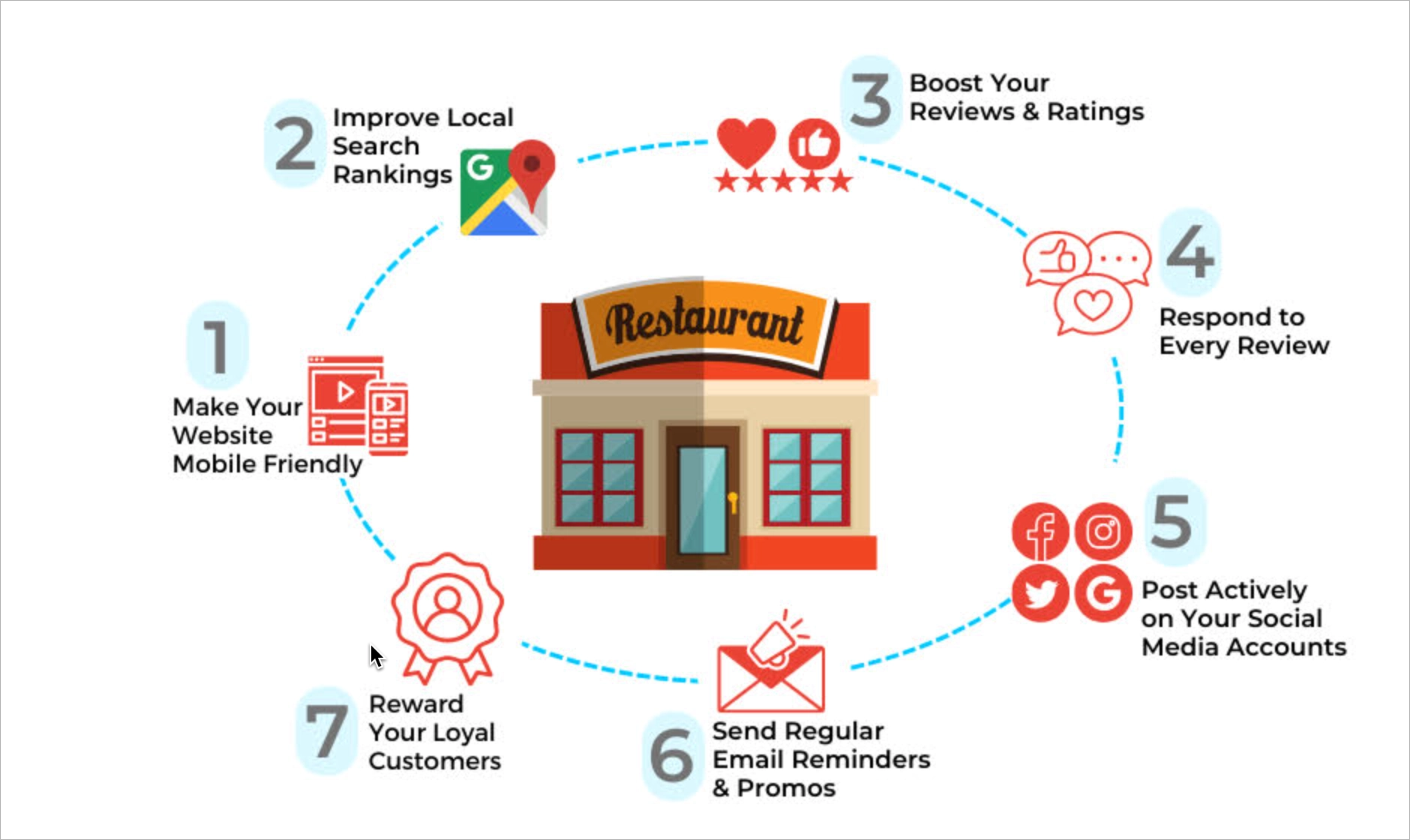
What Is the Best Digital Marketing Strategy for a Restaurant?
The best digital marketing strategy for a restaurant is to use multiple tactics together in a focused way. Each tactic should serve a clear purpose: gaining attention, increasing traffic, and turning visitors into customers.
Start with social media. Restaurants thrive on visuals, and platforms like Instagram and Facebook are ideal for this. Share photos of your food, behind-the-scenes videos, and daily specials. This content gives people a reason to follow and engage with your brand. It also builds trust and encourages word-of-mouth.
Local search is essential. People often search for food nearby, and strong local SEO helps your restaurant appear in those searches. Keep your Google Business Profile accurate and updated. Add location-based keywords to your website and menu pages. Make sure your reviews are visible and recent.
Email marketing helps you stay connected to your past customers. Send updates about new menu items or upcoming events. Offer limited-time deals or birthday discounts. Divide your list into groups (like regular visitors or one-time guests) so messages feel personal and relevant.
Email campaigns work better when they land somewhere smart. Create high-converting pages in minutes—try Landingi now.
Paid ads can expand your reach quickly. Use search ads for people looking for specific food types in your area. Run targeted ads on social media to promote seasonal specials or happy hours. These platforms offer detailed targeting by age, location, and interests.
Use analytics to measure what works. Track how many people click on your ads, open your emails, or find you through Google. Adjust your campaigns based on what brings the most results. This makes your budget work smarter, not harder.
How to Create a Digital Marketing Strategy for Restaurants?
To create a digital marketing strategy for a restaurant, start by knowing exactly who your ideal customer is and what goals you want to reach. This focus helps you choose the right tools and methods to promote your restaurant online. It sets the stage for attracting more customers, boosting web traffic, and building stronger relationships.
Think about your audience. Are you targeting families, office workers, or food lovers? Look at their age, habits, location, and dining preferences. This helps you craft messages that speak directly to them and guide them to your business.
Once you define your audience and goals, build your online presence. Start with a website that loads fast, works well on mobile, and is easy to use. Add current menus, booking options, contact details, and an order system. These features help customers make quick decisions and follow through.
Make sure people nearby can find you. Restaurants depend heavily on local foot traffic, so invest in local SEO. Register on Google Business Profile and keep your listings updated. Use location-based keywords on your site and landing pages to show up in nearby searches.
After that, choose the best digital channels for your goals. Social media helps build a following and stay top of mind. Paid ads on Google or Facebook help you reach people fast. Email marketing keeps loyal customers informed and engaged with news, deals, or events.
Social Media Marketing
Use social media to share updates, respond to comments, and feature user-generated content. This keeps your audience engaged and builds trust. Run simple contests and stay active to encourage interaction.
Choose platforms based on your audience. Instagram works best for users aged 18–24, according to Backlinko. For the 25–34 group, Statista shows Facebook is more popular. Focus your efforts where your target customers already spend time.
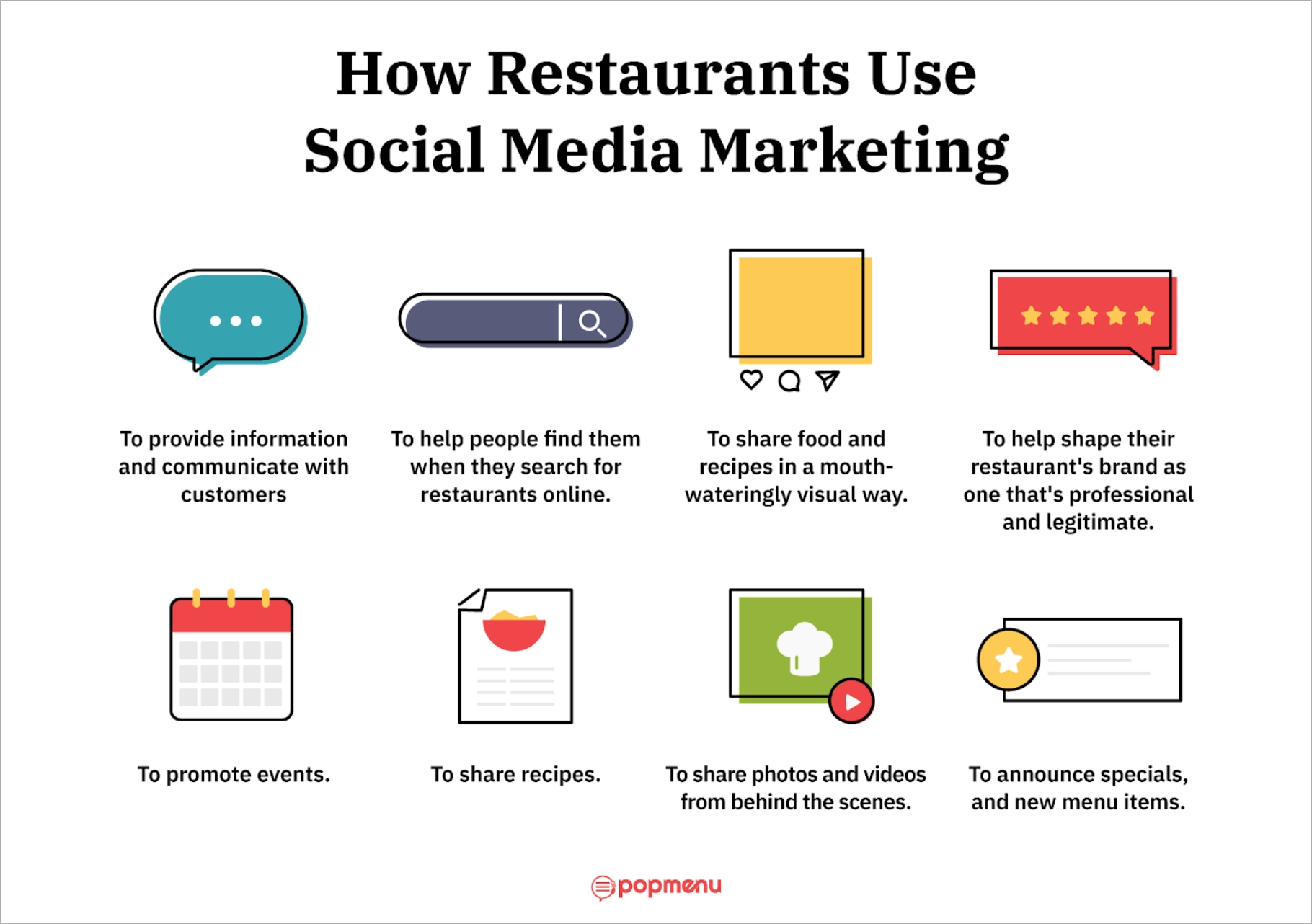
Email Marketing
Email is a direct, cost-effective way to keep your customers informed and engaged. Use it to promote new menu items, events, or special offers. Offer sign-up perks like loyalty rewards to grow your list.
Always link emails to a focused landing page (like a special offer or booking page) to boost conversions. These pages help turn interest into action and improve your campaign’s performance.
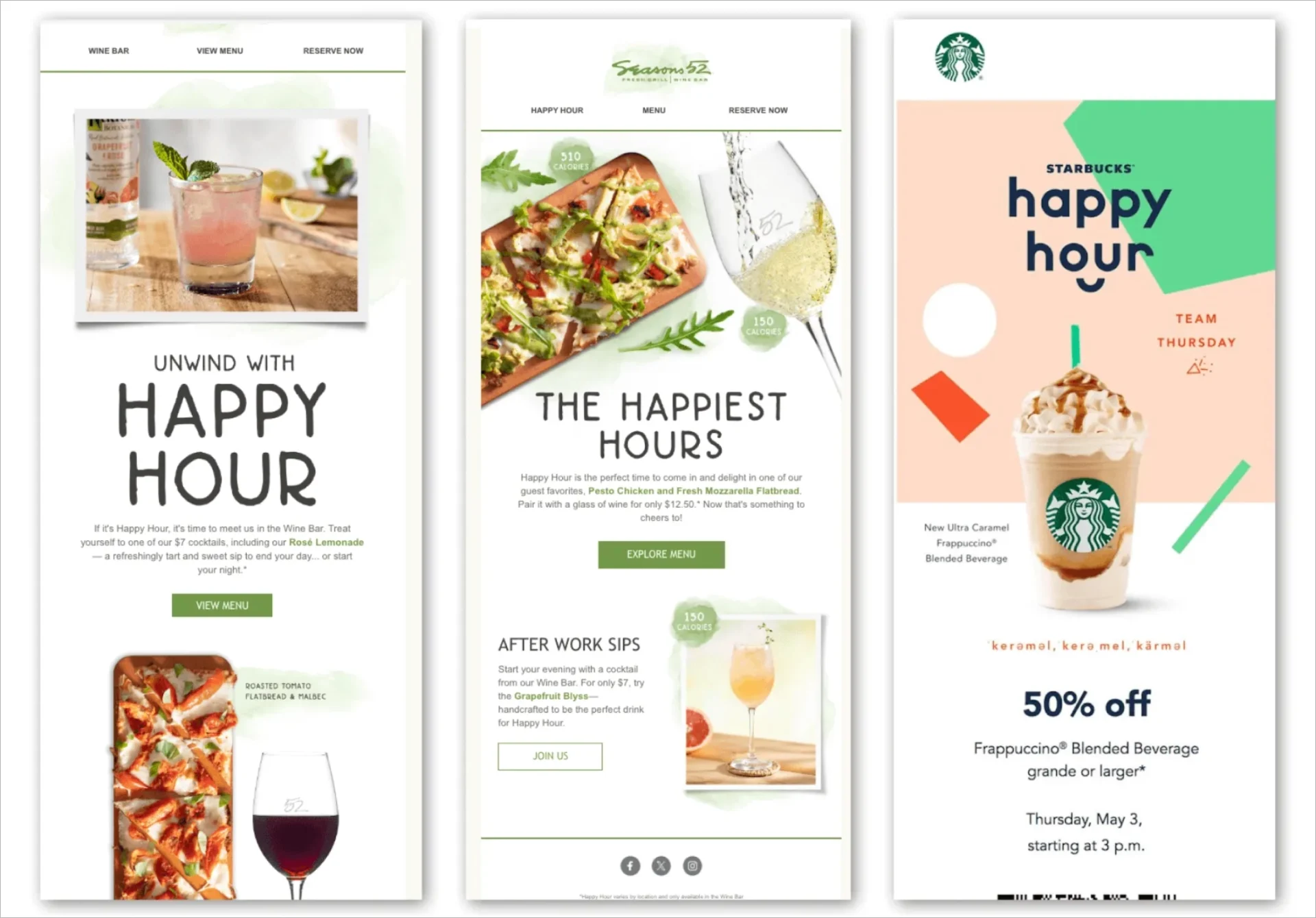
Paid Advertising Campaigns
Paid ads help you reach new customers quickly. Platforms like Google Ads and Facebook allow you to target by location, interests, or behavior. Use strong visuals and short, clear copy to grab attention.
Track performance with tools like Google Analytics. Adjust based on what drives clicks, bookings, or orders. Done right, paid ads can deliver real results and increase your restaurant’s visibility.
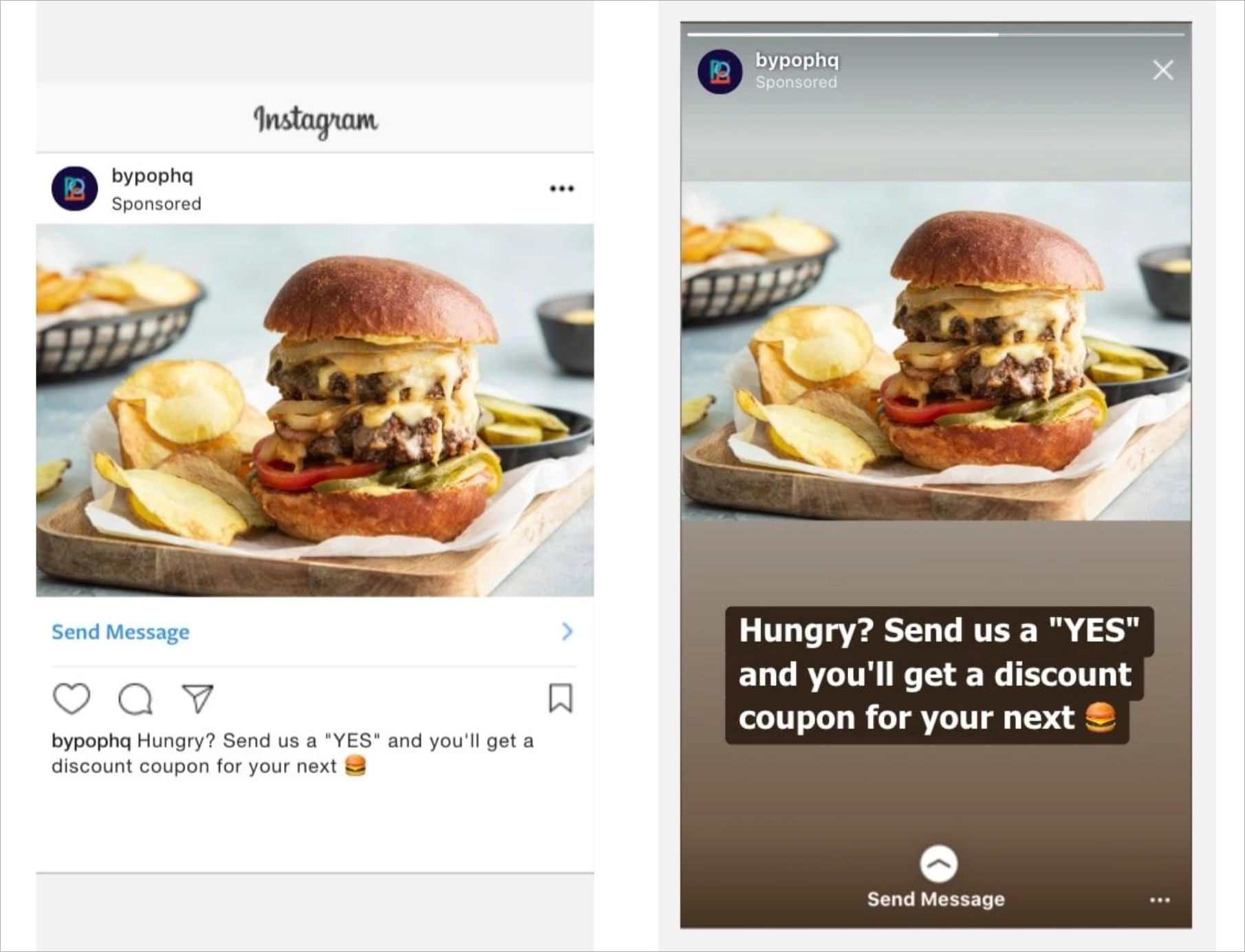
6 Tips in Digital Marketing for Restaurant
Strong digital marketing helps restaurants attract more customers, grow local visibility, and build lasting loyalty. These six methods help you improve your online presence and turn interest into visits and repeat business.
Start with these clear, effective strategies to bring in more traffic and keep your customers coming back.
1. Make Your Website Work for You
Your website should make it easy for customers to find info, view your menu, and place orders. It must load quickly, look great on mobile devices, and be easy to navigate.
Use clear calls to action, like “Order Now” or “Book a Table.” Make sure your menu is online, up to date, and easy to read. Add real customer reviews and appealing photos of your food. These build trust and help new visitors decide to visit your restaurant.
2. Use Local SEO to Be Found Nearby
Make sure people nearby can find your restaurant in local searches. Claim and update your Google Business Profile. Add your address, phone number, website, hours, and menu.
Use your city and neighborhood name in your website content and headings. Ask customers to leave Google reviews to improve your local ranking. This helps more people find you, especially those searching for a place to eat nearby.
3. Work With Local Influencers
Partnering with local food bloggers or social media influencers can introduce your restaurant to new customers. Choose influencers who already speak to the type of people you want to reach.
Ask them to share photos, reviews, or videos of their visit. This builds interest, encourages social sharing, and brings more people to your restaurant. Influencers add credibility that advertising alone can’t always offer.
Make social proof the star of your landing page! The builder gives you the tools to do it right.
4. Make Online Ordering and Booking Easy
Customers expect to place orders or book a table online without calling. Add simple online systems to your website so visitors can take action fast.
Make sure your ordering and reservation tools work on mobile and are easy to use. Share these tools on your social media and email campaigns. This adds convenience and can help drive more repeat visits.
5. Use Ads to Reach Specific Customers
Paid ads on Google, Facebook, and Instagram help target local people who are likely to visit. Set your ads to reach nearby users based on age, interests, or time of day.
You can promote lunch specials to people working in the area or target weekend diners. Ads also give detailed tracking, so you can see what’s working and adjust your budget based on results.
When your landing page speaks the same language as your ad, results follow. Discover how to create that perfect sync.
6. Direct Campaigns to Landing Pages
Landing pages help you turn interest into action. Each ad, email, or social post should link to a specific page with one clear offer.
For example, if you’re promoting a 20% discount for first-time orders, create a landing page where people can claim the code. This makes tracking easier and helps build your email list for future marketing.
3 Examples of Digital Marketing in Restaurant Business
Digital marketing helps restaurants attract more guests, grow online visibility, and build stronger customer relationships. Below are three restaurant brands that use clear and effective digital strategies to support their growth. These examples show how to use marketing tools without overcomplicating the process.
1. Well-Designed Website: San Laurel
A clear, fast, and mobile-friendly website is essential for attracting new restaurant customers online.
San Laurel, a restaurant based in Los Angeles, shows how a simple website can make a big difference. Their homepage presents essential information without distractions. Menus, location, and booking options are easy to find without scrolling or searching.
The layout is clean, and large images show off the food and interior, helping visitors imagine the dining experience. This kind of visual appeal builds interest before a customer even steps through the door.

The website includes an online reservation system, which makes booking a table simple. It’s also optimized for search, so it appears when someone looks for restaurants in the area.
The speed of the site, along with its structure, helps search engines rank it better. As a result, the restaurant is easier to discover by locals or tourists searching nearby.
Finally, the design reflects the restaurant’s brand – modern, elegant, and calm. This creates a smooth bridge between digital and in-person experiences.
2. Social Media: Langosteria
Social media builds awareness, attracts new followers, and keeps regular guests connected to the restaurant experience.
Langosteria, a well-known Italian restaurant group, uses Instagram to strengthen its brand and grow its audience. Their posts highlight daily dishes, team members, and behind-the-scenes moments from the kitchen. Each post tells a visual story, helping followers connect with the restaurant on a personal level.
High-quality food photography makes their feed attractive and memorable. Short videos show how dishes are prepared or plated, offering a deeper view of the restaurant’s craft. These posts do more than showcase the food – they give personality to the brand.

Langosteria keeps its audience engaged by posting regularly and replying to comments and messages. This two-way communication helps build a loyal community that feels part of the brand, not just visitors.
By interacting with their followers and using location tags and relevant hashtags, they also increase their visibility across Instagram. This draws the attention of new potential diners, both locals and travelers.
Their consistent approach shows how social media can become a real source of traffic, turning followers into guests.
3. Local SEO: Padella
Local SEO helps restaurants appear in search results when people nearby look for places to eat.
Padella, an Italian restaurant in London, uses local SEO to attract guests actively searching for Italian food in the area. Their Google Business Profile includes their address, phone number, hours, and up-to-date menus. This information appears right when someone searches for terms like “Italian food near me” or “pasta in London.”

The listing includes photos of dishes, the dining space, and customer reviews, all of which help people decide quickly. Padella encourages guests to leave reviews, which boosts trust and improves their search visibility. High ratings and fresh reviews influence new customers choosing where to eat.

The restaurant’s website supports this effort by using keywords that match what people search for online. Phrases like “fresh pasta in London” or “Borough Market restaurant” help search engines show their site to the right audience.
They also add clear directions and maps, making it easier for people to find the location on foot or by transit.
This mix of on-site content and third-party platforms builds trust and drives both online and in-person traffic. Padella’s strategy shows how SEO isn’t just technical – it’s practical and measurable.
Why is Digital Marketing Important for Restaurants?
Digital marketing matters for restaurants because it helps them get found, grow sales, and build strong customer relationships. Most customers look online before choosing where to eat, so visibility is key. If your restaurant doesn’t show up in search results, you’re missing potential diners.
Marketing tools like SEO, social media, and online directories make it easier for restaurants to appear in front of hungry customers.
Digital channels such as Instagram, Facebook, and email let restaurants connect directly with people. These platforms help share updates, promote events, and respond to feedback. Personalized offers and loyalty messages can also keep regulars coming back. Clear, two-way communication builds trust and encourages repeat visits.
Online marketing makes it easy to promote takeout, delivery, and reservations. These services need to be visible where customers spend time – on mobile devices and social apps. A simple link or button can turn a visitor into a paying guest. Convenience can boost conversions, especially when people are deciding quickly.
Reviews are another reason why digital marketing is so powerful. Platforms like Google and Yelp influence how people choose restaurants. Responding to feedback shows that you care. Encouraging happy guests to share their experience creates trust and helps attract new customers.
Paid ads can also be effective when used with the right targeting. You can show ads based on someone’s location, dining habits, or even the time of day. This kind of precision means your budget is spent reaching the people most likely to visit or order.
In short, digital marketing helps restaurants be visible, stay connected, and turn interest into revenue. It gives restaurant owners control over their brand and customer experience in a world that’s increasingly driven by screens and search bars.
Align your landing page with your ads and turn hungry browsers into loyal guests.
What’s the Use of Landing Pages in Digital Marketing for Restaurants?
Landing pages help restaurants turn online visitors into paying customers by focusing on one clear goal. Unlike a general website, a landing page is built for a specific campaign – like promoting a special offer or collecting sign-ups. This narrow focus makes it easier to guide users toward an action, such as booking a table or joining a loyalty program.
Restaurants often run seasonal events, limited-time menus, or discounts. A landing page gives each promotion its own space, which helps grab attention and drive results. With fewer distractions, visitors are more likely to act. The layout and content are streamlined, so users don’t have to search for what to do next.
Using landing pages also improves how well your digital marketing performs. Campaigns through paid ads or email become more effective when visitors land on a page built just for that message. You get better conversions, and your budget goes further. Restaurant landing pages that include local keywords and useful content can also bring in more organic traffic from search engines.
Each campaign should have its own landing page. This makes it easier to track results and refine your approach. Tools like Landingi simplify the process, offering templates and drag-and-drop editing. You don’t need to code or design from scratch to build a page that works well and looks good.

Landingi includes helpful features for restaurants. You can use its AI tools to write content, adjust images, and improve search performance. Built-in A/B testing lets you try out different versions of your page to see what drives the most action – like which headline or button works better. You can also track user behavior with EventTracker, so you know what’s working and what needs to change.
With over 180 available integrations, Landingi can connect with your email tools, CRM, and analytics platforms. This makes it easier to keep your marketing organized and efficient. If your goal is to increase reservations, get more leads, or boost visibility for a new offer, landing pages can help you get there faster and with better results.
Grab attention and boost conversions with this mouthwatering restaurant landing page template. Perfect for showcasing your menu and turning hungry visitors into loyal customers.
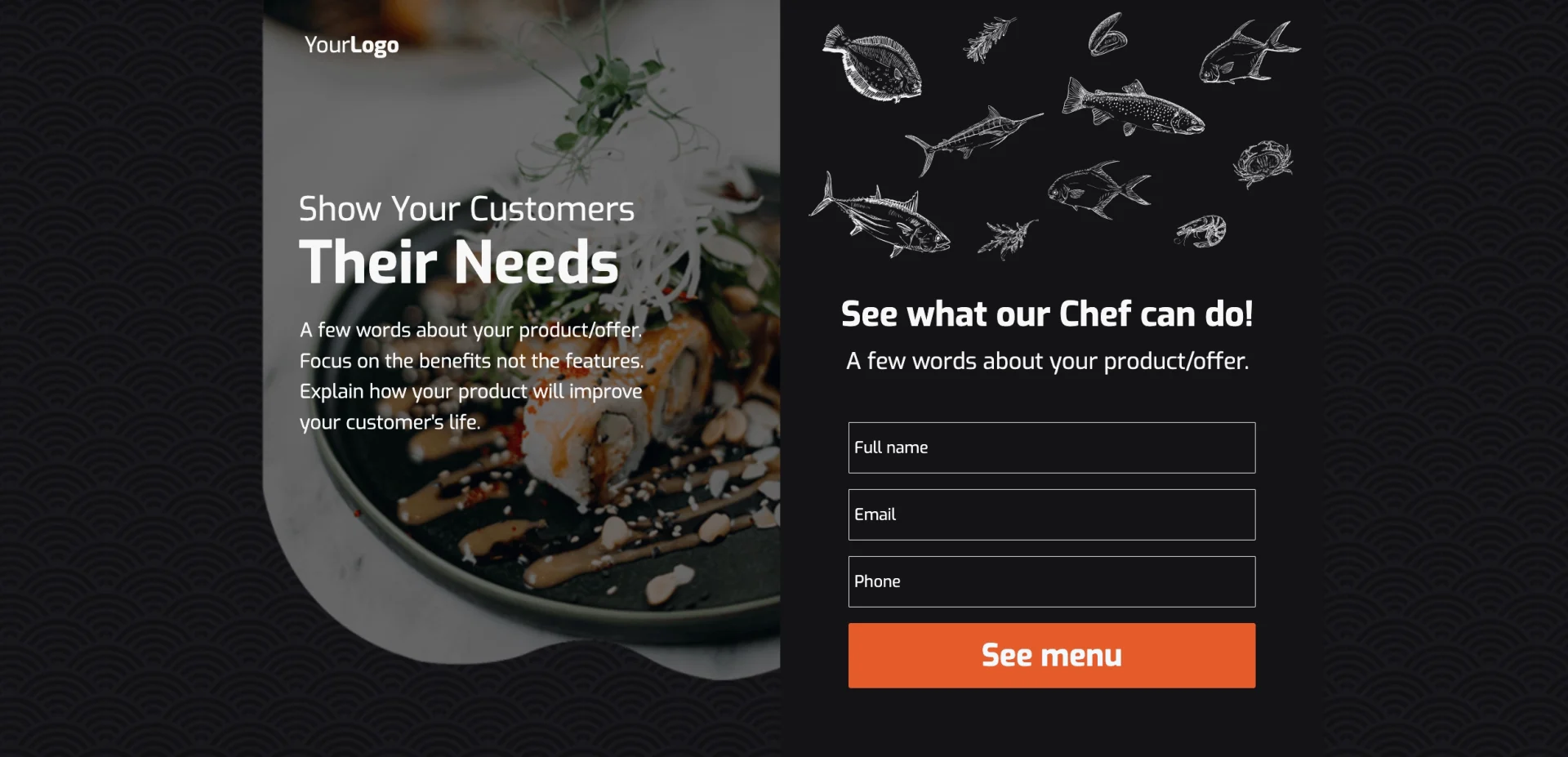
What’s the Use of AI in Digital Marketing for Restaurants?
AI helps restaurants run smarter marketing by using data to create better, faster, and more personalized campaigns. With AI tools, restaurants can analyze customer behavior and send targeted offers based on preferences – like customized emails or ads people actually want to see.
AI is also useful for managing online reviews, which directly impact a restaurant’s reputation. Instead of replying emotionally or inconsistently, AI can write responses that stay polite, clear, and on-brand. This keeps communication professional and saves time.
Restaurants can improve their websites and landing pages with AI content tools. These platforms can quickly write SEO-friendly text that highlights promotions and encourages bookings or orders. They’re built to keep users engaged and guide them to take action.
AI can also create landing pages in different languages within minutes. This is useful for reaching local communities or attracting tourists. Multi-language pages help restaurants speak directly to more people without needing extra staff.
Using AI boosts efficiency across all channels. It helps teams make faster decisions, test new ideas, and improve the customer journey without wasting time. For restaurants trying to compete online, AI makes marketing easier to manage and more effective.
Build a landing page in minutes—just pick, prompt, and publish. Perfect for busy restaurant marketers.
What Are the Benefits of Digital Marketing for Restaurants?
Digital marketing helps restaurants attract more local customers and boost sales through targeted, measurable strategies. It gives restaurants a way to reach people searching online for food options nearby – exactly when they’re ready to decide. This approach brings more traffic to both your website and your physical location.
Paid ads on platforms like Google or Facebook help restaurants reach specific groups of customers. You can promote new menu items, special deals, or events to the right people at the right time. These platforms offer detailed targeting based on location, age, interests, and behavior.
Social media and email campaigns build direct connections with your audience. Responding to comments, sending personalized offers, or asking for feedback makes customers feel heard. These efforts improve customer satisfaction and encourage repeat visits.
Digital marketing is also cost-effective. It allows restaurants to test different campaigns, track results, and adjust spending based on performance. Instead of wasting money on broad ads, you can target exactly who you want to reach and measure what works.
A clear and consistent online presence helps shape your restaurant’s identity. Using strong visuals, simple messaging, and authentic content makes your brand more recognizable. It gives new customers a reason to try your food and regulars a reason to return.
Most importantly, digital marketing increases your local visibility. With strong SEO and active listings on platforms like Google Maps or Yelp, more nearby customers can find you. This kind of exposure directly drives more foot traffic and phone orders.
In short, digital marketing gives restaurants practical tools to grow – affordably, locally, and with real customer connections.
What Are the Limitations of Digital Marketing for Restaurants?
Digital marketing can help restaurants grow, but it also demands time, money, and constant attention to stay effective. Running campaigns, creating content, and managing reviews often requires dedicated staff or outside help – costs that may strain smaller businesses.
Competing in busy markets raises ad prices and makes visibility harder to achieve without a strong budget. High-quality visuals, influencer collaborations, and paid promotions add to the expense and often need expert input to deliver real results.
Negative reviews are another serious challenge. Even a few poor ratings on platforms like Google can hurt a restaurant’s reputation. Managing this feedback takes time and care to avoid long-term brand damage.
Digital marketing is not a one-time effort – it requires ongoing work. Regular updates, trend monitoring, and fast responses to online activity are all necessary. For many restaurant owners, this means juggling daily operations with complex digital tasks.
Online trends, algorithms, and platforms change frequently. Staying current means learning new tools, adjusting strategies, and sometimes starting from scratch – all while running a restaurant.
Attract More Diners with Conversion-Optimized Landing Pages
Landing pages are one of the easiest ways to turn online visitors into real customers for your restaurant. Unlike a homepage, they focus on a single goal (like booking a table, ordering takeout, or claiming a special offer), making it easier for people to act.
Every ad or promotion should lead to a clean, mobile-friendly page with a clear message and call to action. This keeps visitors focused, lowers bounce rates, and boosts conversions.
Want to promote a lunch deal, new menu item, or event? A dedicated landing page lets you show exactly what people clicked to see. Tailored content leads to better results, especially when matched to specific audiences or platforms.
That’s where Landingi can help. It lets you build and launch professional landing pages in minutes – no coding needed. You can test different versions, track what’s working, and keep improving without relying on a developer. If you’re serious about growing your customer base, optimized landing pages are a must – and Landingi makes it easy to start.






